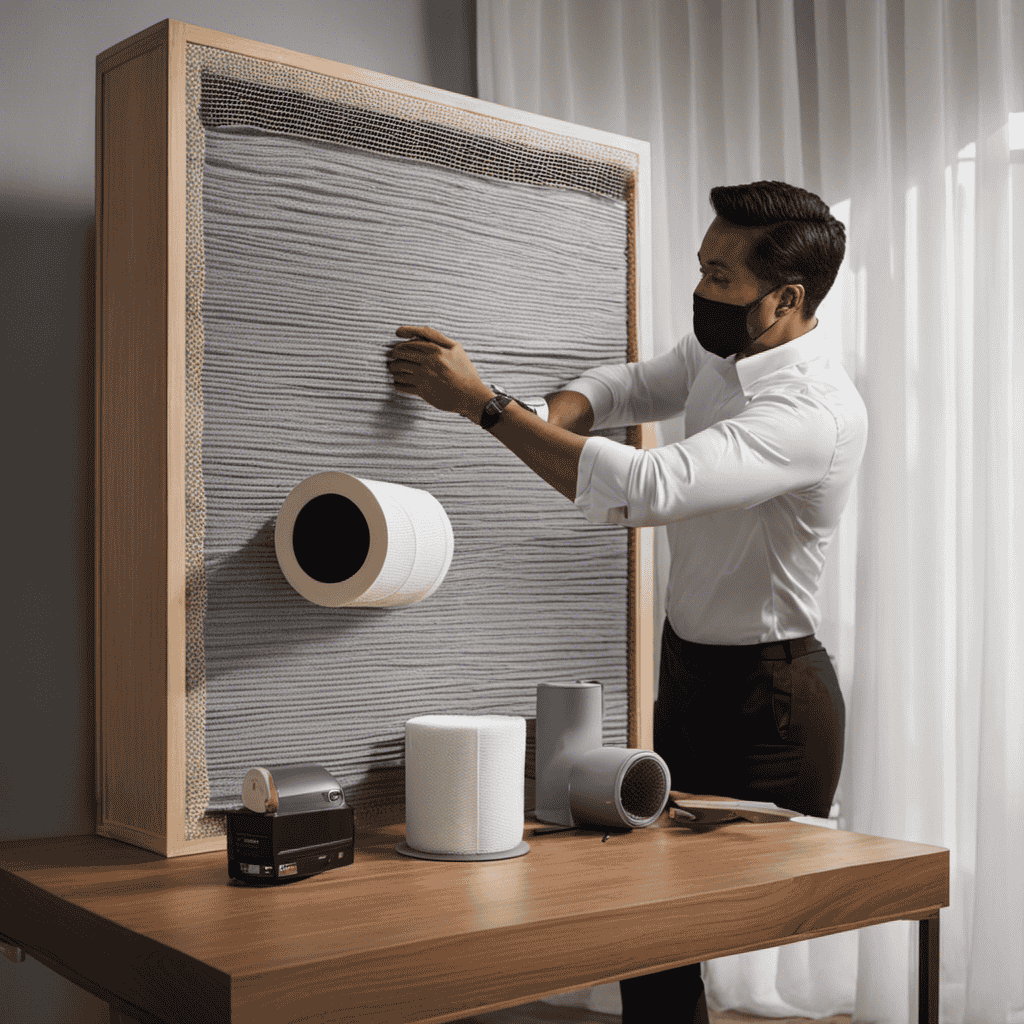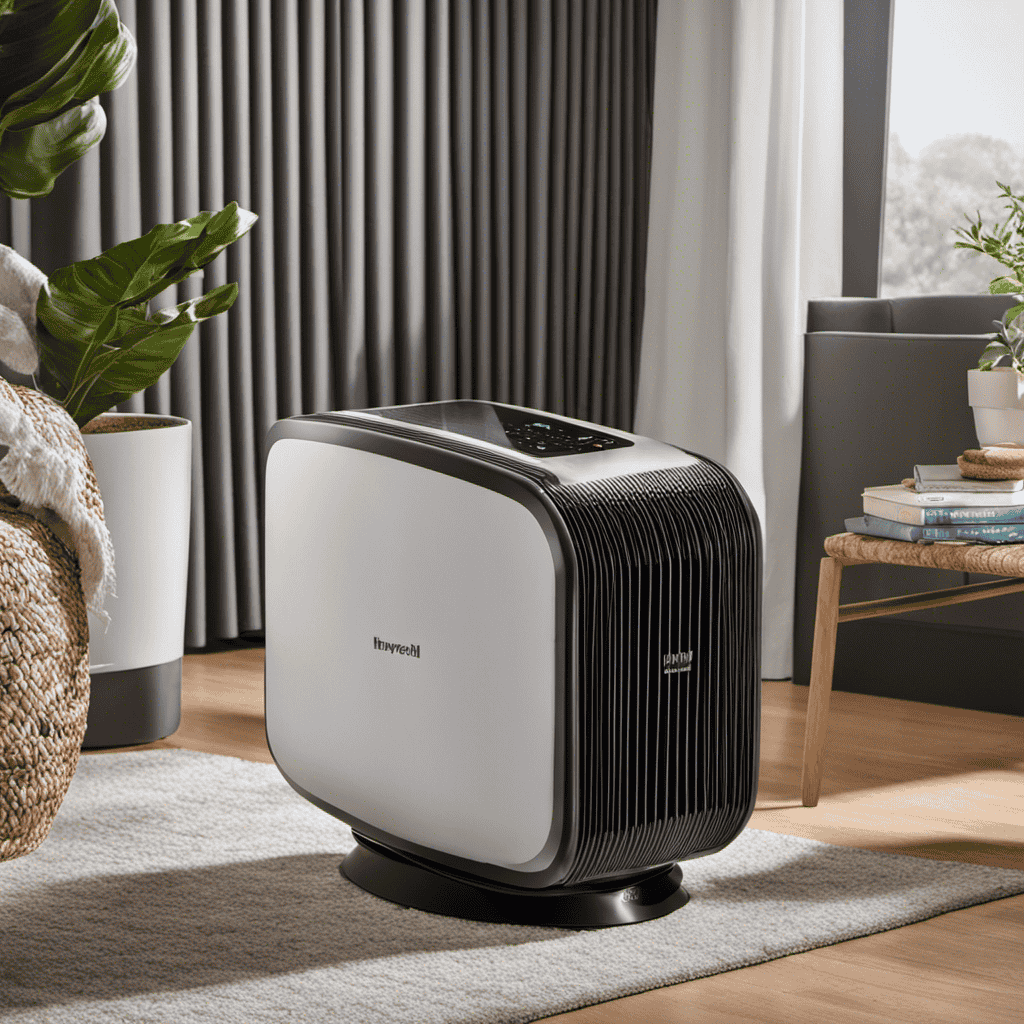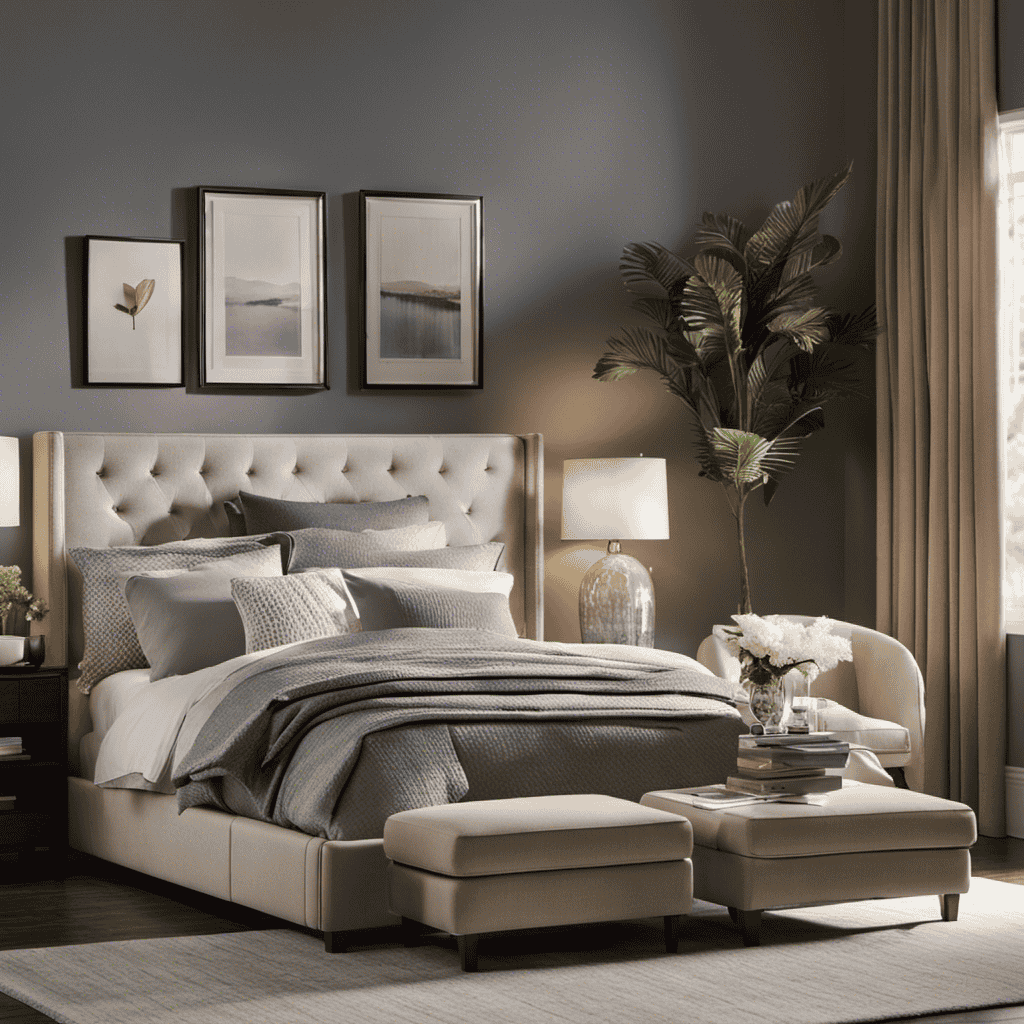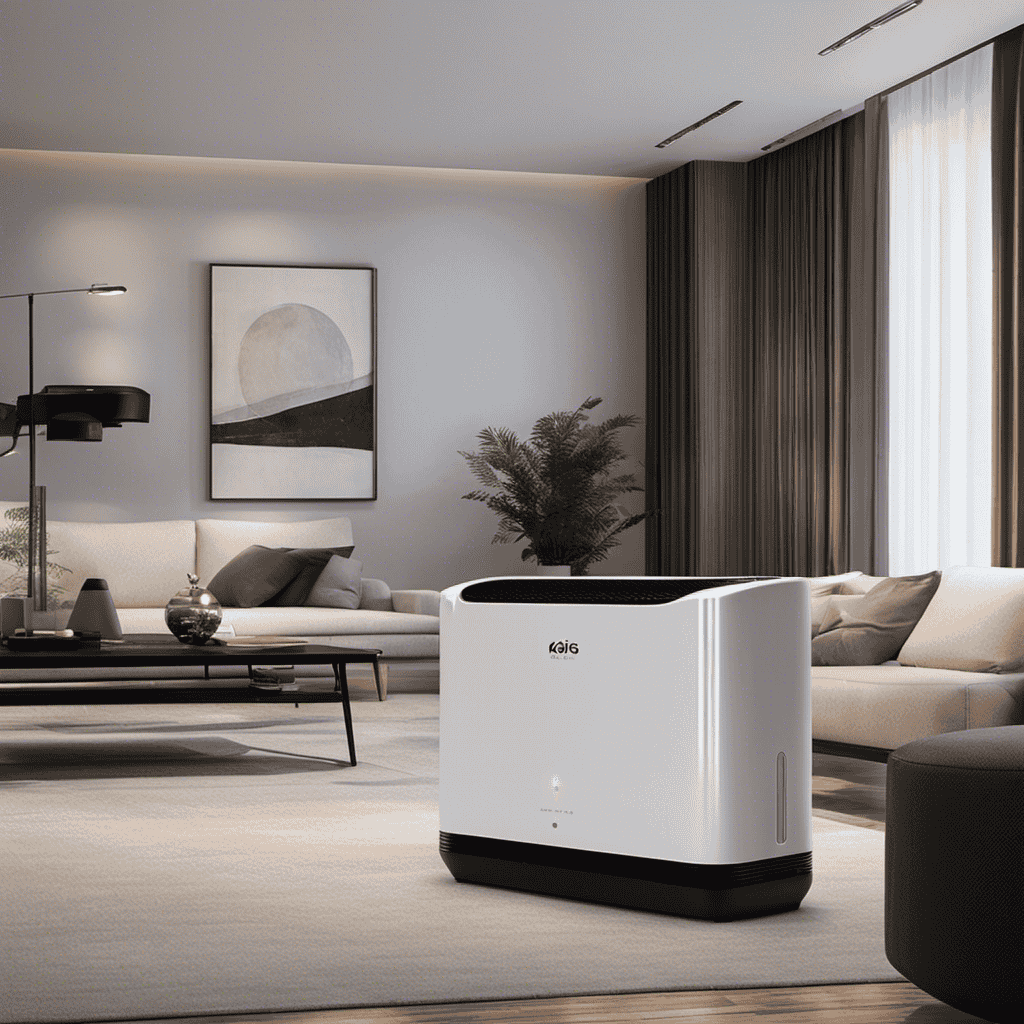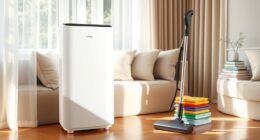You might believe that crafting your air purifier filter is a complicated and overwhelming endeavor. However, I can guarantee it’s simpler than you might imagine.
In this article, I will guide you through the process step-by-step, providing you with all the necessary information and tips to create an effective air purifier filter.
So, if you’re ready to take control of the air quality in your home, let’s get started.
Key Takeaways
- Air purifier filters can remove airborne contaminants such as dust, pollen, pet dander, and mold spores.
- Understanding filtration techniques is crucial in choosing the right materials for a DIY filter.
- Material efficiency, cost-effectiveness, durability, and lifespan are important factors to consider when selecting filter materials.
- Washable filters, bamboo filters, activated carbon filters, and electrostatic filters are efficient and cost-effective options for DIY air purifier filters.
Understanding the Basics of Air Purification
To understand the basics of air purification, you need to know how an air purifier filter works.
Air purifier filters are designed to remove airborne contaminants from the air, such as dust, pollen, pet dander, and mold spores. These filters use various filtration techniques to capture and trap these contaminants, ensuring cleaner and healthier air.
One common filtration technique is mechanical filtration, which uses a dense mesh or fibrous material to physically capture particles as air passes through the filter.
Another technique is electrostatic filtration, where particles are charged and attracted to an oppositely charged filter.
Activated carbon filtration is also used to remove odors and chemicals from the air.
Understanding these filtration techniques is crucial in choosing the right materials for your DIY filter, which I will discuss in the next section.
Choosing the Right Materials for Your DIY Filter
When it comes to choosing the right materials for your DIY air filter, there are several key points to consider.
First, you’ll want to explore the different options for material efficiency, as this will determine how effectively the filter can capture and remove airborne particles.
Additionally, it’s important to find cost-effective filter materials that can provide high performance without breaking the bank.
Lastly, you’ll want to assess the durability and lifespan of the materials, ensuring that they can withstand continuous use and maintain their effectiveness over time.
Material Efficiency Options
There are a few different material efficiency options you could consider for your air purifier filter.
When it comes to reusability options, a washable filter is a great choice. These filters can be easily cleaned and reused multiple times, reducing waste and saving money in the long run.
Another eco-friendly alternative is a filter made from sustainable materials such as bamboo or activated carbon. These materials are renewable and biodegradable, making them a more environmentally friendly option.
Additionally, using an electrostatic filter can enhance material efficiency by attracting and capturing smaller particles with static electricity. This type of filter is effective and can be easily cleaned or replaced when necessary.
Cost-Effective Filter Materials
Using sustainable filter materials, such as bamboo or activated carbon, can be a cost-effective option for your air purifier. These materials stand out for their effectiveness and affordability when it comes to affordable alternatives and DIY filter hacks.
Bamboo filters are not only eco-friendly but also possess natural antimicrobial properties, making them a great choice for filtering out pollutants and harmful particles. On the other hand, activated carbon filters are highly porous and have a large surface area, which allows them to trap a wide range of contaminants, including odors and chemicals.
Durability and Lifespan
Bamboo and activated carbon filters have a long lifespan, making them durable options for improving air quality. When considering durability factors, it is important to look at the materials used and their ability to withstand prolonged usage.
Here are three key reasons why bamboo and activated carbon filters have an extended lifespan:
-
Natural Strength: Bamboo is known for its strength and resilience, making it a durable choice for air filters. Its natural fibers can withstand wear and tear, ensuring the filter remains effective over time.
-
Chemical Absorption: Activated carbon filters have a high adsorption capacity, meaning they can trap and remove a wide range of pollutants from the air. This ability allows the filter to maintain its efficacy for an extended period.
-
Regeneration Capability: Both bamboo and activated carbon filters have the ability to be regenerated, further extending their lifespan. With proper maintenance and cleaning, these filters can be reused multiple times, making them a cost-effective option in the long run.
Step-by-Step Guide to Building Your Air Purifier Filter
Start by gathering all the necessary materials to build your air purifier filter. When it comes to DIY filter alternatives, there are a few options to consider.
One effective homemade filter can be made using a box fan and a high-efficiency furnace filter. These filters are designed to capture small particles and can be easily found in hardware stores. To assemble your homemade air purifier, simply attach the furnace filter to the back of the box fan using tape or zip ties. Make sure the air flows through the filter, not around it.
This DIY filter alternative can be highly effective in removing airborne pollutants from your home.
Now that you have your filter ready, let’s move on to some tips and tricks for effective filtration.
Tips and Tricks for Effective Filtration
One effective way to maximize filtration efficiency is by regularly cleaning or replacing the filter in your homemade air purifier. Here are three tips and tricks to improve airflow and maximize filter effectiveness:
-
Clean or Replace the Filter Regularly: Over time, the filter in your air purifier can become clogged with dust, allergens, and other particles. Regularly cleaning or replacing the filter ensures that it can effectively capture and remove pollutants from the air.
-
Use High-Quality Filters: Investing in high-quality filters can significantly improve the filtration efficiency of your homemade air purifier. Look for filters with a high MERV (Minimum Efficiency Reporting Value) rating, as they can effectively capture smaller particles.
-
Maintain Proper Airflow: Ensure that your air purifier is positioned in a way that allows for proper airflow. Avoid placing it against a wall or in a corner, as this can restrict airflow and reduce filter effectiveness. Additionally, regularly dusting and vacuuming the surrounding area can prevent the accumulation of particles that could hinder airflow and filter performance.
Maintaining and Cleaning Your Homemade Air Filter
To keep your homemade air filtration system running efficiently, it’s important to regularly clean or replace the filter. Proper filter maintenance ensures that your air purifier continues to effectively remove pollutants from the air in your home. Here are some cleaning techniques and tips to help you maintain your homemade air filter:
| Cleaning Technique | Frequency |
|---|---|
| Vacuuming | Every 2 weeks |
| Washing | Every 3 months |
| Air-drying | Once a month |
| Filter replacement | Every 6 months |
| Inspection | Every month |
Vacuuming the filter helps remove larger particles and debris. Washing the filter with mild soap and water can remove smaller particles trapped in the filter fibers. After washing, make sure to air-dry the filter completely before reinstalling. Regularly inspect the filter for signs of damage or clogging and replace it every 6 months to ensure optimal performance. By following these cleaning techniques and maintaining your homemade air filter, you can enjoy clean and fresh air in your home.
Troubleshooting Common Issues With DIY Filters
If you’re experiencing any issues with your homemade air filtration system, there are a few common troubleshooting steps you can take. Here are three things to check when troubleshooting filter performance and DIY filter maintenance:
-
Check the filter placement: Ensure that the filter is properly installed and securely fitted in the air purifier. Any gaps or improper alignment can lead to reduced filtration efficiency.
-
Clean or replace the filter: Over time, the filter may become clogged with dust and debris, hindering its performance. Regularly clean or replace the filter according to the manufacturer’s instructions to maintain optimal filtration.
-
Inspect the fan and motor: If the air purifier is not functioning properly, check if the fan is running smoothly and the motor is operating as it should. Any issues with these components can affect the overall performance of the filtration system.
Enhancing Air Quality: Additional Measures to Consider
When it comes to enhancing air quality, there are several additional measures to consider.
One effective option is incorporating indoor plants, which can help remove pollutants and improve overall air quality.
Another option is using natural air fresheners, which can provide a pleasant aroma without the harmful chemicals found in synthetic air fresheners.
Lastly, proper ventilation techniques, such as opening windows or using exhaust fans, can help circulate fresh air and remove stale air, improving the overall air quality in your space.
Indoor Plants for Air Quality
Indoor plants can help improve air quality in your home. They are not only aesthetically pleasing but also serve as natural air purifiers. Here are the best indoor plants that can effectively remove toxins from the air:
-
Spider Plant (Chlorophytum comosum): This plant is known for its ability to remove formaldehyde and xylene from the air. It requires bright, indirect light and should be watered moderately.
-
Snake Plant (Sansevieria trifasciata): Also known as the ‘mother-in-law’s tongue,’ this plant is highly effective in filtering out toxins like benzene and trichloroethylene. It can tolerate low light conditions and requires minimal watering.
-
Peace Lily (Spathiphyllum): This beautiful plant helps remove pollutants like ammonia, benzene, and formaldehyde. It prefers medium to low light and should be watered regularly.
To ensure optimal air-purifying benefits, it’s important to provide these plants with proper care. This includes placing them in appropriate lighting conditions, watering them correctly, and occasionally wiping their leaves to remove dust.
Natural Air Fresheners
Using natural air fresheners is a great way to keep your home smelling fresh and clean without relying on artificial fragrances. Natural air fresheners are made from ingredients that are safe for both you and the environment.
One option is to make your own homemade air filters using essential oils. Simply mix a few drops of your favorite essential oil with water in a spray bottle and spritz it around the room. The pleasant scent will linger in the air, providing a refreshing and natural fragrance.
Another option is to use natural odor absorbers such as baking soda, vinegar, or activated charcoal. These substances work by absorbing and neutralizing odors rather than masking them with artificial fragrances.
Proper Ventilation Techniques
To enhance the effectiveness of natural air fresheners, you should open windows or use fans to allow fresh air to circulate and remove any lingering odors. Proper ventilation techniques are essential in maintaining good indoor air quality.
Here are three important things to consider when it comes to air circulation:
-
Cross-ventilation: Opening windows on opposite sides of a room creates a flow of air, allowing for better circulation and the removal of stale air.
-
Exhaust fans: Installing exhaust fans in kitchens and bathrooms helps to remove pollutants and moisture from the air. This prevents the buildup of odors and reduces the risk of mold and mildew growth.
-
Air purifiers: Investing in an air purifier with a built-in fan can help to improve air circulation and filtration. These devices remove airborne particles, allergens, and odors, ensuring cleaner and fresher indoor air.
Frequently Asked Questions
What Are the Potential Health Benefits of Using an Air Purifier Filter?
Using an air purifier filter can provide potential health benefits by removing pollutants from the air, reducing the risk of respiratory issues. Compared to other methods, it is an effective and convenient way to improve indoor air quality.
Can I Use Any Type of Filter Material for My DIY Air Purifier Filter?
I can’t use any type of filter material for my DIY air purifier filter. It’s important to consider the different types and their effectiveness. Some filters are better at removing certain pollutants than others.
How Often Should I Replace or Clean My Homemade Air Filter?
I should replace or clean my homemade air filter regularly to maintain its effectiveness. The replacement frequency depends on factors like air quality and usage. Cleaning methods may include vacuuming or washing the filter material.
Are There Any Safety Precautions I Should Take When Building or Operating My DIY Air Purifier Filter?
When building an air purifier filter, it is important to take safety precautions to ensure proper functioning. Following a precise building process and using the right materials can minimize risks and maximize the effectiveness of the filter.
Can I Use My Homemade Air Filter in Larger Spaces or Should It Be Limited to Smaller Rooms?
Using homemade air filters in commercial spaces may not be cost-effective. It is important to consider the size and air quality requirements of the room. Consulting with a professional or using commercial-grade filters is advisable.
Conclusion
In conclusion, building your own air purifier filter can be a cost-effective and efficient way to improve the air quality in your home.
By understanding the basics of air purification and choosing the right materials, you can create a filter that effectively removes pollutants and allergens from the air.
Regular maintenance and cleaning will ensure that your homemade filter continues to work effectively.
Remember to consider additional measures, such as proper ventilation and reducing indoor pollutants, to further enhance the air quality in your home.
Take control of your indoor environment and breathe easier with your homemade air purifier filter.
